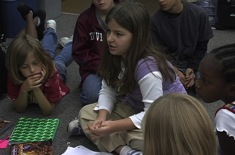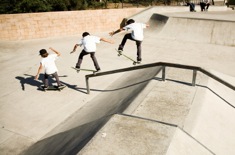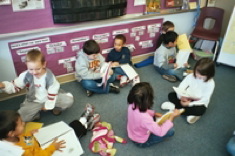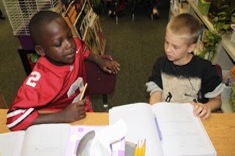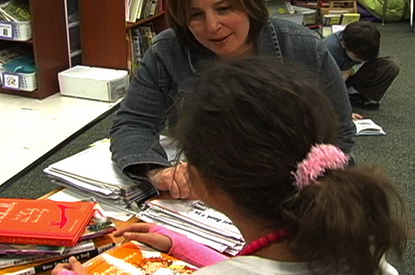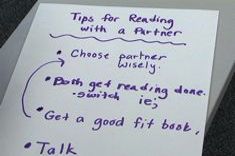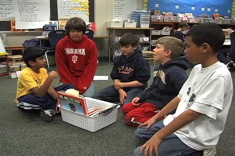Mercy Watson is always causing trouble, but I don’t think she means to. She doesn’t always know what she’s doing.
Abby, age 6
“I love Roald Dahl books, so reading ‘Boy’ is really fun. It makes sense that he had such an interesting life. My favorite part is when he put a dead mouse in a candy jar at the sweet shop. I’m sure Roald Dahl is going to get caught, but somebody else actually gets blamed,”
Eli, age 10
“Look at this book I’m reading. It has a character named Curly and it said that old, bald men get that nickname. It’s just like the guy named Curly in ‘Hoot!’ The Curly in this book acts a lot like him!”
Mitchell, age 7
Students at any age are capable of rigorous thinking about texts. To help them get there we must show them what rigorous thinking looks like and how it sounds when we share. With a goal of “ramping up” comprehension and building a strong reading community, I’ve developed a structure for peer conferring that allows students to engage in and share rigorous thinking about the books they read.
In “The Modeling Phase,” I’m thoughtful about providing a number of excellent models for students. Students develop an understanding of the structure and the type of thinking that is expected in a peer conference by watching both adults and their peers engage in quality book conversations. Using the Peer Conferring Guide as a reference, students highlight the desired characteristics they observe in the model conference. After several model conferences, students are able to articulate what they have seen and what is being asked of them in a peer conference.
Typically after four or five model conferences, students are anxious to give conferring a try. I am aware that careful attention to gradual release at this stage in the game will pay off by making quality conversations an important part of the reading workshop for the entire school year. The next steps provide an opportunity for students to try on conferring while receiving meaningful feedback.
Fishbowl
In many of the classrooms where I work, students sit in table groups. Groups of four provide a perfect set-up for trying on conferences and giving and receiving feedback. If students don’t sit in table groups, I recommend that students move chairs so that two groups of two are facing one another.
To prepare for the “fishbowl,” I select one table group to provide a model. Before asking the class to form a circle around this table group, I practice a conference and give feedback to the students in the table group. In one classroom, my coaching sounded something like this:
Amanda: Grace and Sam, you two are going to have a peer conference, just like you’ve seen modeled the last few days. Hector and Nate, your job will be to follow the “peer conferring guide” to make sure that Grace and Sam are remembering all the steps in the conference. You’re also listening to make sure they are sharing quality thinking about their books. Why don’t we give it a try before the class joins us to watch?
Hector: How do we know they are sharing quality thinking?
Amanda: Good question. Let’s think about what we’ve heard during our model peer conferences. What do you remember about the types of things that were shared?
Grace: I remember that people shared what they were thinking about the book, and gave examples from their books, too.
Amanda: Exactly. What you’re looking for, Hector and Nate, is thinking about the text, not just opinions. Let’s give it a try.
Grace and Sam begin their conference while Hector and Nate look on, Peer Conferring Guides and highlighters in hand. As the conference comes to a close, Hector and Nate finish with their highlighting and look to Grace and Sam.
Amanda: Nate and Hector, what did you notice about Grace and Sam’s conference?
Nate: Grace, you did a great job of making eye contact and showing Sam that you were really listening.
Hector: Sam, good job sharing about your book.
Amanda: Okay, guys, nice positive feedback. Was there anything on your peer conferring form that was missing from that conference? What did you notice about the thinking they shared?
Hector: Well Sam, I heard that you thought the book was really funny, but I’m not quite sure why. I would like to have heard more about what made the book funny for you.
Amanda: That type of feedback will give Sam what he needs to share more of his thinking. Let’s invite the class to participate and show them exactly what you just did so that everybody knows what it sounds like when we give meaningful feedback, respectfully.
I invite the class to form a circle around this group, confident that these students will provide a strong model for conferring and giving feedback to their peers in a way that is both constructive and thoughtful. Once the class has the chance to observe their peers in the fishbowl and ask clarifying questions, they are ready and anxious to give it a go.
Students return to their own table groups, armed with highlighters and peer conferring guides. Groups are given the green light to start conferring. As they try conferring and giving feedback, the teacher is moving between groups, providing coaching where necessary.
It’s Beginning to Sound a Lot Like Conferring
This is always an exciting day for me, as I’m blown away by the engagement, thinking, and sharing that is demonstrated during this careful release. One student paraphrases “I heard you say…” Another questions, “Will you tell me more about the Remake Center?” A partner exclaims, “Oh, no! Spoiler Alert!” Eye contact, head nods, and “thank yous” assure me that students are not just trying on the language and thinking, but understanding the social skills required of great conversations as well.
Having an opportunity to confer and provide meaningful feedback is important for each student. This small-group structure can be repeated until everybody has had the chance to try both roles, and the teacher begins to consistently observe evidence of students really using the structure and sharing real thinking about books.
Things are moving now! Students are well on their way to internalizing the peer conferring structure and they are becoming more adept at sharing quality thinking about what they’ve read. In the last part of this series, I’ll describe how I’ve released students to confer with peers independently, and share some positive feedback from students and teachers as well as obstacles to plan for and overcome.

